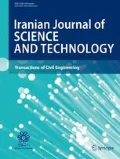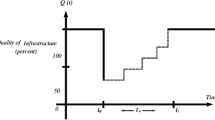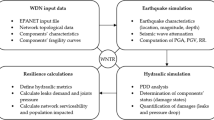Abstract
Water distribution network (WDN) is one of the infrastructures which provide welfare and comfort for people in their life. This role is magnified in critical situations like earthquake occurrence since WDN will suffer from breaks and leakages. Efforts to lessen the impact of earthquake are on reducing both the extent and the severity of damage, and the time to restore service given by WDN. Thus, for understanding exact damages, the key role of accurate analysis in both seismic and hydraulic terms is not negligible. In this study, pipeline damage caused by seismic wave propagation is modeled using relationships obtained from the 1994 Northridge earthquake. The time of repairs in WDNs is calculated regarding accurate hydraulic analysis based on the head-driven simulation method. Additionally, a suitable index is introduced which can show the effect of repairs on nodal pressures during repair process. After defining new terms for risk assessment on the basis of Federal Emergency Management Agency (FEMA) method, this approach is applied to a part of Tehran’s WDN to assess the capabilities of the proposed model. Since there is no special damage relationship for Iran, some available damage relationships were applied to a part of Tehran’s WDN and results showed that HAZUS (Washington D.C. Department of Homeland Security Emergency Preparedness and Response, FEMA, Mitigation Division, New York, 2003) relationship predicted more damages. In other words, the highest risk, the largest number of accidents (pipe bursts, pipe disengagement and pipe leakage) and the maximum value of restoration time were obtained from HAZUS (2003) relationship. Two risk mitigation scenarios were defined to assess the response of water supply system to earthquake impacts including decreasing demand and use of wells. Results showed that decreasing demand by 20% leads to decrease in risk, so that the maximum decrease was calculated in the case of using O’Rourke and Jeon damage relationship (risk decreased from 1.01 × 10−5 to 8.26 × 10−6). But using wells after earthquakes can be more effective on decreasing risk after earthquake. Outcomes from case study express that this model can be applied to every city having both earthquake catalogue and WDN’s model to show number of failures and leaks in pipes, risk of each repair rate relation and pressure index for earthquake scenarios.





Similar content being viewed by others
References
ALA (2001) Seismic fragility formulations for water systems. American Lifelines Alliance, New York
Baker JW (2008) An introduction to probabilistic seismic hazard analysis (PSHA). Handbook, Version 1.3
Ballantyne DB, Berg E, Kennedy J, Reneau R, Wu D (1990) Earthquake loss estimation modeling of the Seattle water system. Technical Report, Seattle
Brink SA (2009) Simulation of post-earthquake water supply restoration: calibration and application. MSc. Thesis, Department of Civil and Environmental Engineering, University of Delaware, Newark, USA
Chung R, Ballantyne D, Comeau E, Holzer T, Madrzykowski D, Schiff A, Stone W, Wilcoski J, Borcherdt R, Cooper J, Lew H, Moehle J, Sheng L, Taylor A, Buckle I, Hayes J, Leyendecker E, O’Rourke T, Singh M, Whitney M (1996) January 17, 1995 Hyogoken-Nanbu (Kobe) earthquake: performance of structures, lifelines, and fire protection systems. NIST SP 901 (ISCCS TR18) National Institute of Standards and Technology, Gaithersburg, Maryland
Eskandari M, Omidvar B, Modiri M, Nekooie MA, Alesheikh AA (2017) Geospatial analysis of earthquake damage probability of water pipelines due to multi-hazard failure. Int J Geo-Inf 6:169. https://doi.org/10.3390/ijgi6060169
FEMA 452 (2005) A how to guide to mitigate potential terrorist attacks against buildings. Risk Management Series
Ghodrati Amiri G, Mahdavian A, Manouchehri Dana F (2007) Attenuation relationships for Iran. J Earthq Eng 11(4):469–492
HAZUS (2003) Washington D.C. Department of Homeland Security Emergency Preparedness and Response, FEMA, Mitigation Division, New York
He SH (2014) Functional reliability analysis of post-earthquake water supply system. Appl Mech Mater 438:1551–1554
Islamic Republic of Iran Vice Presidency for Strategic Planning and Supervision (IRIVPSPS) (2011) Guidelines for design of urban and rural water supply and distribution systems. Report No. 117–3 (first revision). Islamic Republic of Iran Vice Presidency for Strategic Planning and Supervision Press, Iran
JICA (2006) The study on water supply system resistant to earthquakes in Tehran municipality. Tehran Province Water and Wastewater Authority, Tehran
Laucelli D, Giustolisi O (2015) Vulnerability assessment of water distribution networks under seismic actions. J Water Resour Plan Manag. https://doi.org/10.1061/(asce)wr.1943-5452.0000478,04014082
Mani A, Tabesh M, Zolfaghari MR (2013) Hydraulic performance of post-earthquake water distribution networks based on head driven simulation method. Water Sci Technol Water Supply 13(5):1241–1249
Markov IJ (1994) Seismic serviceability of water supply networks with application to San Francisco Auxiliary Water Supply System. PhD. Thesis, Cornell University, New York, USA
McReynolds L, Simmons RL (1995) LA’s rehearsal for the big one. J Am Water Works Assoc 87:65–70
O’Rourke M, Deyoe E (2004) Seismic damage to segmented buried pipe. Earthq Spectra 20:1167–1183
O’Rourke TD, Jeon SS (2001) Seismic zonation for lifelines and utilities, Invited keynote paper on lifelines. In: 6th International conference on seismic zonation, Palm Springs, EERI, CA
Pathirana A (2010) EPANET desktop application for pressure driven demand modeling. In: The 12th annual water distribution systems analysis conference (WDSA 2010), Tucson, Arizona, USA
Roozbahani A (2012) Risk based decision making model for urban water systems management. PhD. Thesis, School of Civil Engineering, University of Tehran, Tehran, Iran
Shi P (2006) Seismic response modeling of water supply systems. PhD. Thesis, Cornell University, New York, USA
Shinozuka M, Rose A, Eguchi RT (1998) Engineering and socioeconomic impacts of earthquakes. Multidisciplinary Center for Earthquake Engineering Research, Monograph Series 2, Buffalo, NY
Shirzad A (2017) Shortening the search time in optimization of water distribution networks. Urban Water J 14(10):1038–1044
Shirzad A, Tabesh M (2016) New indices for reliability assessment of water distribution networks. J Water Supply: Res Technol-Aqua 65(5):384–395
Tabesh M, Tanyimboh TT, Burrows R (2002) Head driven simulation of water supply networks. Int J Eng Trans A 15(1):11–22
Tabucchi T, Davidson R (2008) Post-earthquake restoration of the Los Angeles water supply system. MCEER-08-008, Multidisciplinary Center for Earthquake Engineering Research, Buffalo, New York
Toprak S (1998) Earthquake effects on buried lifeline systems. PhD. Thesis, Cornell University, New York, USA
United States Environmental Protection Agency (EPA) (2018) Earthquake resilience guide for water and wastewater utilities. EPA 810-B-18-001.A 810-B-18-001
Wagner JM, Shamir U, Marks DH (1988) Water distribution reliability: simulation methods. J Water Resour Plan Manag 114(3):276–294
Yoo DG, Jung D, Kang D, Kim JH (2016) Seismic-reliability-based optimal layout of a water distribution network. Water 8:50. https://doi.org/10.3390/w8020050
Zolfaghari MR, Peyghaleh E, Akbari Niari M (2010) Modeling the effect of earthquake induced damage to urban water network on intra-structure ignition following earthquakes. In: 14th European conference on Earthquake Engineering, Macedonia
Author information
Authors and Affiliations
Corresponding author
Rights and permissions
About this article
Cite this article
Tabesh, M., Moshtaghi, M. & Shirzad, A. Risk Analysis and Management of Water Distribution Networks Due to Probable Earthquake. Iran J Sci Technol Trans Civ Eng 44, 723–734 (2020). https://doi.org/10.1007/s40996-019-00262-2
Received:
Accepted:
Published:
Issue Date:
DOI: https://doi.org/10.1007/s40996-019-00262-2




